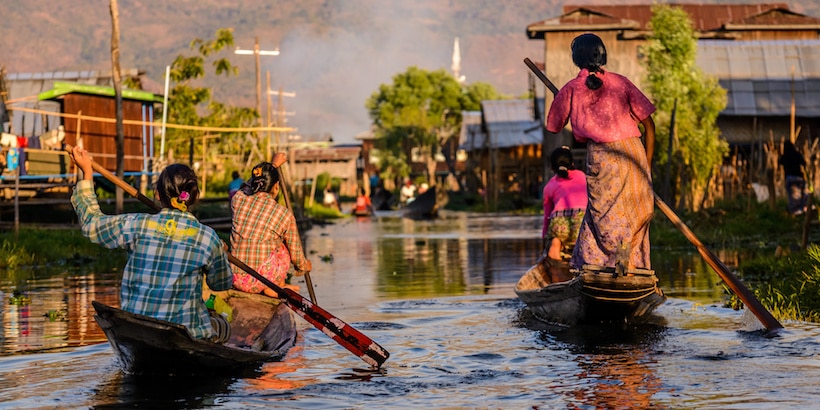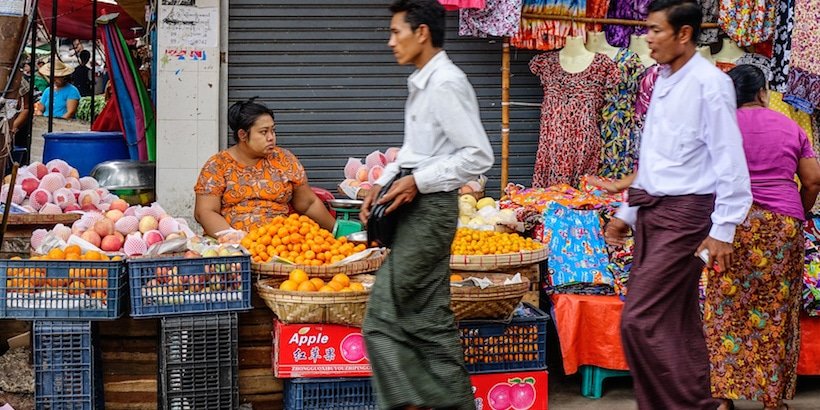Burmese Longyi
A special multi-functional garment
One of an interesting scenes that you see in Myanmar is a street full of skirt-wearing men. Actually this special garment is quite basic and pretty functional in Myanmar. Learn about some fun facts now.
[wpseo_breadcrumb]
Things You Didn't Know Before ...
- Much the same as shoes, suit and tie in the western world, Longyi with flip-flops are the formal looks in Myanmar. No need to feel offended seeing your tour guide in such an attire.
- Longyi is not Myanmar's patent as it is also prevelant in India, Sri Lanka and other Asian regions, but with different names and fashions.
- Although looking much similar to a layman, nun and monks' robes and Longyi are different.
- Longyi is the name in general for the two-piece traditional wears; Pasoe is for men's Longyi and Htamein is for women's, which are distinguish in styles and farbics.
5 Fun Facts on Burmese Longyi
Nothing says more about a country and its people than the daily outfits. Before your trip to Myanmar, take some time to learn about Burmese Longyi, which doesn't only buff off the culture shocks but also helps you gain insights while peeking into the Burmese' day-to-day life.
1. History: No Official Records, Changes Overtime
There is no official record on the first appearance of Longyi in Myanmar. The word Longyi was previously used to refer to a sarong-wearing Malay man, which might give a clue of where it was from. However, during the Konbaung Dynasty in the 1750s, Longyi became prevelant as many important court officals made extensive decoration in their daily outfit -- jewlery hanging on the head dress, embroidery and silk were used on the strapes on the bottom piece. Adjustments have been made overtime to better adapt the weather and daily-life needs, especially after the British rules when more and more Indian immigrants moved into Myanmar and brought in their understanding of the attire.
2. Styles: Ankle-Long, Seamless Sheet & Various Farbics
Pasoe, the Longyi for men is longer than women's Htamein. As for men, a set of Pasoe comes in two pieces: sewing pants and tight pants, former of which is actually a 2-meter long, 80cm wide, seamless sheet that is wrapped around the wasit outside the tight pants. Cotton is the main farbic of all times while silk and later on Indonesia batik become high-end trends, which were only used by the rich and important or common people for special events. A round-collar shirt tops the upper body and it's used to hold personal items because Longyi has no pockets. Plain colors are the best choices, black, navy blue or grey, but now you can also see some colorfully-patterned ones.
3. Multi-Functional: Light, Cool & Always Ready to Go
Longyi used to be a tell of one's social ranking in the past. The rich and important were in silk farbics and strapes decorated with beautiful embroidery while their wives would show off waist bands with precious stones or gold. Nowadays, Longyi is much more down-to-earth, just a daily outfit that helps air circulate to keep the wearer cool in the tropical heat. Longyi is tied without a belt, wrap it up and one is ready to go, pretty handy for farmers, fishermen and labor workers in general. It can also be used as a blanket, a side sling bag, a shawl, a scarf or something to hide from the sun.
4. How & When to Wear: 4 Easy Steps at Any Occasion
Wearing a Longyi is pretty much the same as wrapping up the baby but in this very case, you are the baby. Step one: wrap the entire cloth around your body and fold it up to a proper height -- make sure the down end is slightly above your ankles; step two: hold the two ends of the cloth and tie a knot on one side of your waist; step three: twist the ends again to tighten the knot; step five: adjust the height and fold the left-over part into the knot.
Longyi is both a formal attire and daily wear for Burmese. At important occasions, such as weddings, funerals, conferences or religious ceremonies, men are required to wear a thick jacket over their white round-collar shirts. And a headdress is added on -- a white turban with a protruding corner sharp.
5. Differences: Monks' Robes & Ethnic Minority's Costumes
Although looking pretty much the same, nun and monks' robes hold some nuances. Besides the colors -- nuns' in pink and monks' in orange, the upper body wear is different. For monks, an extra cloth will be used to wrap around the shoulders and be left a long strap on one side and the other shoulder will be exposed. Nuns are not allowed to show their shoulders and they will wear a pink long-sleeve shirt under with a long scarf-like orange cloth to wrap around the upper body and cover the left sholder.
Longyi is also very common among ethnic groups but they have some minor changes to better adapt to their living conditions. For example, Shan people around Inle Lake would don a thick coat over and men's pasoes are relatively shorter -- for them to work the boat better. Mandarin-style tops are very common too.
Start Planning Your Trip to Myanmar
Contact an expert in Myanmar that will support you 1-1 from the initial chat, itinerary design, and even on the trip.






